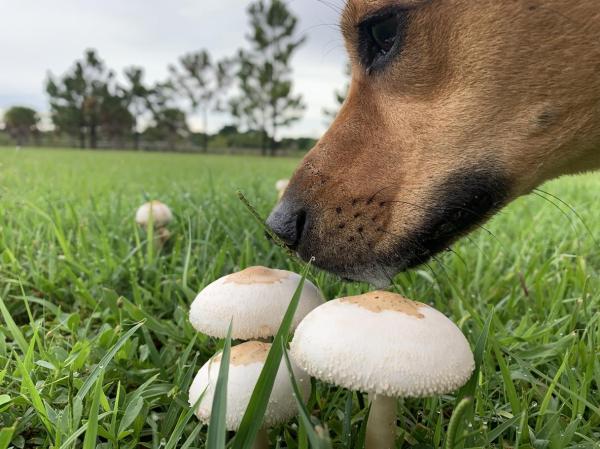
Mushrooms are a large and diverse group of fungi. Some mushrooms are very tasty and nutritious, while others are deadly poisonous. Therefore, it is important that you know which mushrooms are which. Fortunately, store-bought mushrooms are safe for people and dogs, and they are a good source of fiber, essential amino acids and B vitamins. Nevertheless, you should consider a few factors before giving your dog mushrooms.
In the following AnimalWised article, we explain if dogs can eat mushrooms, as well as how to safely feed them to your pup.
Can dogs eat mushrooms?
A mushroom or toadstool is the fleshy, spore-bearing fruiting body of a fungus that usually grows above ground, on the soil or on its food source. Mushrooms are among the healthiest foods on the planet. Each species of mushroom is unique and has its own specific combinations of vitamins, minerals, and antioxidants.
There are also species of mushrooms that are toxic or poisonous to dogs and humans.
For this reason, you should never offer an unfamiliar mushroom to your dog. If you decide to go mushroom picking, you must have sufficient knowledge to distinguish between edible and inedible mushrooms. But even if you do not plan to pick mushrooms, be extra careful when walking your dog in the mountains, because these poisonous mushrooms could attract their attention and lead to poisoning by ingestion.
What mushrooms can dogs eat?
Among edible mushrooms, there are wild mushrooms and cultivated mushrooms. Popular wild mushrooms such as milk cap, penny bun, or fairy ring mushroom are found in the Northern Hemisphere only in spring and fall. Cultivated mushrooms such as oyster mushroom, wood ear mushroom, blue footed mushroom or shiitake mushroom, on the other hand, can be found on the market and in stores all year round.
As a rule, mushrooms that are edible for humans are also edible for dogs. Therefore, you can include them in your dog's ration as long as you do it properly. In the following sections, we will explain how to include mushrooms in your dog's diet.
Should I include mushrooms in my dog's diet?
Dogs, unlike cats, are opportunistic omnivores, meaning they are carnivores but not pure carnivores. This means that they have a digestive system capable of digesting foods that are not of animal origin, including mushrooms.
There is nothing wrong with including mushrooms in your dog's diet, but you must remember that the majority of the diet must be meat of animal origin.
Although commercial feeds usually do not contain mushrooms in their list of ingredients, exceptionally we can find some feeds that contain mushrooms as a raw material. If you feed your dog homemade rations rather than commercial food, you can include mushrooms in their diet.
In dogs, it is important that the intake of proteins of animal and vegetable origin is balanced. Therefore, ingredients that provide proteins of animal origin must constitute at least 60-80% of the daily ration in homemade food. The remaining percentage is composed of foods of non-animal origin such as grains, vegetables, and fruits.
You can also include other foods of non-animal origin, such as mushrooms, as long as you do so in the right proportion (about 3% of the ration may be sufficient). In any case, remember that when feeding your dog homemade rations, be sure to consult a veterinarian specialized in animal nutrition to ensure that your dog's diet is healthy and balanced.
If you are thinking of replacing commercial food with home-cooked food or including it in your dog's feeding, the first thing you should do is consult a veterinarian who specializes in nutrition. Also, do not hesitate to read this other article, in which we offer a complete guide to home-cooked food for dogs.
The benefits of feeding your dog mushrooms
Mushrooms are foods that provide little energy, about 30 kcal per 100 grams. Therefore, it is a suitable food for dogs with overweight or obesity. They are also a good source of fiber, which provides a feeling of satiety without increasing energy intake, improves intestinal transit, regulates stool consistency and promotes the maintenance of the intestinal microbiota.
Compared to vegetables, mushrooms are a good source of essential amino acids. Although they are present only in small amounts, they contain all essential amino acids. Among vitamins, their high content of niacin (vitamin B3) and riboflavin (vitamin B2), which play an important role in energy metabolism, stands out. In addition, niacin contributes to the proper functioning of the nervous system, digestive system and skin, and riboflavin is necessary to maintain the integrity of the skin and mucous membranes. To a lesser extent, they also contain thiamine (vitamin B1) and vitamin C. As for minerals, mushrooms contain significant amounts of potassium, phosphorus, selenium, and iron.
In addition, the consumption of mushrooms has a delaying effect on the development of diabetes and reduces the clinical signs associated with this disease (polyuria, polydipsia, polyphagia and weight loss).
How to give mushrooms to a dog?
You can safely add the mushrooms to your dog's diet if you follow these instructions:
- Rinse the mushrooms to remove any dirt that may be on the cap or stem.
- Then clean them with a dry paper or cloth.
- Chop the mushrooms and fry them in a pan until they are cooked.
- If you want, you can add a few drops of olive oil to cook them, but never add salt.
- You can also cook them with the rest of the ingredients (protein, grains, vegetables, etc.) that you normally have in your daily ration.
At this point, it should be noted that you should not offer your dog mushrooms that have been prepared with other ingredients that are toxic to dogs, such as garlic or onions. Remember that these are toxic foods for dogs that can cause oxidative damage to red blood cells and lead to hemolytic anemia if offered in large quantities.
So, if you decide to offer mushrooms to your dog, make sure they are not accompanied by other ingredients that could be harmful to dogs. You can learn more about this topic in this other article, where we talk about the forbidden foods for dogs.
Poisonous mushrooms for dogs
As we mentioned before, mushrooms that are poisonous to humans are also poisonous to dogs and cause more or less the same symptoms. Although few of the 70-80 species of poisonous mushrooms are actually deadly if ingested, many of these deadly mushrooms bear an unfortunate resemblance to edible species and are therefore particularly dangerous. As a rule (although there are exceptions), mushrooms that have white plates and rings are usually poisonous.
Below we list the most common deadly mushrooms found in the world:
- Death cap (Amanita phalloides): Perhaps the deadliest of all mushrooms, it is found throughout Europe and is very similar to the edible straw mushrooms and Caesar's mushroom.
- Conocybe filaris: is a harmless-looking lawn fungus that is most common in the Pacific Northwest and can be deadly if eaten.
- Webcaps (Cortinarius species): The two webcap species, the deadly webcap (Cortinarius rubellus) and the fool's webcap (Cortinarius orellanus), look very similar to each other and to a number of edible species.
- Autumn Skullcap (Galerina marginata): Common throughout the Northern Hemisphere and parts of Australia, Galerina marginata is a gilled, wood-feeding fungus that contains the same amatoxins as skullcap. Consumption causes diarrhea, vomiting, hypothermia, and liver damage and can lead to death if untreated.
- Destroying Angels (Amanita species): Destroying angels are actually several species of all-white mushrooms in the genus Amanita. These incredibly poisonous mushrooms look very similar to edible tuberous-leaf mushrooms and meadow mushrooms, and have often been accidentally collected.
- Deadly Dapperling (Lepiota brunneoincarnata): The Deadly Dapperling is a gill fungus known to contain amatoxins. Widely distributed throughout Europe and parts of Asia, the mushroom is fairly harmless and is mistaken for edible varieties, although poisoning is not very common. Accidental consumption results in severe liver toxicity and can be fatal if not treated immediately.
What happens when a dog eats poisonous mushrooms?
Poisonous mushrooms can cause two types of poisoning:
- Long incubation period: Poisonings with a long incubation period are usually more serious and in many cases result in death.
- Short incubation period: Mushroom poisoning with a short incubation period is typically milder and manifests itself in the form of digestive disorders and hallucinations. So we must remember that poisoning by toxic mushrooms does not always manifest itself immediately after ingestion, but the first symptoms may appear after a few hours.
If your dog may have been poisoned, contact a veterinarian immediately; there is no real treatment for eating poisonous mushrooms at home. If there are any mushrooms left, bring one in for identification or take a photo. If you want to know more about what to do if you suspect your dog has been poisoned, read this other article on dog poisoning.

If you want to read similar articles to Can Dogs Eat Mushrooms?, we recommend you visit our Homemade diets category.
- European Federation of Pet Food Manufacturers. (2017). Nutritional guides for complete and complementary foods for dogs.
- Ministry of Agriculture, Fisheries and Food. Mushroom . Retrieved from: https://www.mapa.gob.es/es/ministerio/servicios/informacion/champi%C3%B1on_tcm30-102343.pdf